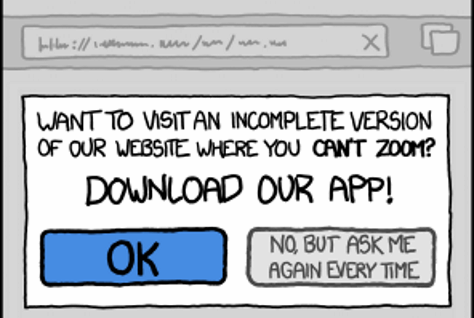The Tivo Remote
Like any self-respecting geek, I’m a card-carrying member of the Tivo cult.
I’ll admit, I have lost some interest in the box since Tivo has taken such a hard-line approach to digital rights management (DRM) – providing virtually no way to copy the shows I’ve recorded to DVD, video-CD, or my computer’s hard drive... which is what drove me to Windows MCE. But I digress!
Tivo is lauded for its outstanding user interface, and rightfully so. It may sound like a cliche, but I really did buy my Mom a Tivo for Christmas, and she’s able to use it with no coaching from me. Tivo is easily the single best out-of-box consumer product experience I’ve had in the last 5 years. What’s not as well understood is how the Tivo remote is, similarly, a model of excellent industrial design.
But here’s what really disturbs me. How many years have manufacturers been building television remotes? forty? fifty? If we haven’t nailed usability for something as simple as a television remote by now – clearly we’ve got our work cut out for us to make complex software usable.
New York Times
February 19, 2004
Now Preening on the Coffee Table: The TiVo Remote Control
By KATIE HAFNER
To most home viewers, remote controls may seem like ancillary sidekicks to the main attraction that is the television, DVD player or digital video recorder. Yet in some ways the remote has become the centerpiece of home entertainment: so many functions have been relegated to this slip of an object that if it is lost, you may find yourself unable to do so much as call up a menu for watching the movie you popped into the DVD player.
But if the remote control is a linchpin, it is also often an inscrutable one. A typical remote may have some 40 buttons, with functions that are hard to divine. Often the labels – “toggle,” “planner” and the like – are no help. The device can feel like an afterthought, thrown together without any planning at all.
Increasingly, however, electronics companies are recognizing that building an easy-to-use remote control is an important and challenging task. To improve the remote, they are deploying teams of experienced industrial designers who focus on the product for months - and reaching out to consumers for advice.
In 1998, design engineers at TiVo, the Silicon Valley company that helped introduce the digital video recorder to the world, set out to produce a distinctive remote control. The result was a textbook blend of complexity and ease of use.
The peanut-shaped TiVo remote is at once playful and functional. A smiling TV set with feet and rabbit ears, the company’s logo, graces the top. Distinctive buttons like a green thumbs-up and a red thumbs-down button have helped the remote win design awards from the Consumer Electronics Association.
“They did a really good job,” said Jakob Nielsen of the Nielsen Norman Group, a technology consulting firm in Fremont, Calif. Mr. Nielsen called the oversize yellow pause button in the middle of the remote “the most beautiful pause button I’ve ever seen.”
When Paul Newby, TiVo’s director of consumer design, arrived in June 1998, as the company was just starting up, he and a team of six designers were given 14 weeks to come up with a functioning remote control. Along the way they relied not only on their own instincts but also on feedback from potential users on everything from the feel of the device in the hand to the best place for the batteries.
Mr. Newby, 45, a mechanical engineer, came to TiVo by way of designing much larger objects - Caterpillar construction equipment, to be specific. Designing something that was by comparison microscopic was an inviting challenge.
Many remotes are monochromatic slices of hard plastic. For years, they have generally stuck to the old design conventions, a rectangle with neat rows and columns of buttons lined up like so many cadets.
“They were designed by – and I hate to say it because I am one of them – engineers,” Mr. Newby said.
Mr. Nielsen said: “They work well if you’re sitting in bright light and you have good eyesight and you’re 20 or 30 years old. They’re overloaded with features you don’t really need except once a year or once a lifetime.”
The shape of the remote – the subtlety of how it feels in the hand – was Mr. Newby’s first major design consideration.
Because of the nature of the TiVo video recorder, the remote is held for long periods as users continually choose shows to record, skip commercials, fast-forward and rewind recorded shows, rate programs by pressing the thumbs-up or thumbs-down buttons, and even pause live TV. Designing a remote that consumers would find comfortable was a high priority.
Central to the process, Mr. Newby said, was producing prototypes “early, ugly and often.”
Ugly?
“There tends to be this conservatism in the design process,” he said. “I encourage young designers to go off and scare me.”
Some of the results fell under the category of “Be careful what you wish for.” One sketch was of a remote that looked like a horned toad. Another resembled an ice scraper for a windshield.
In the pursuit of ease of use, the design team struggled with how to symbolize the notion of rating a program, an unfamiliar button concept for most viewers. (By telling the machines what kinds of shows they like or dislike, users “teach” TiVo what programs to record on its own).
“Rather than pick some esoteric technical term about ‘preferred’ or ‘not preferred’ television programming, we came up with the thumbs,” Mr. Newby said.
Hundreds of sketches were quickly narrowed to dozens, and three-dimensional models were carved from rigid foam in the shape of spoons, slabs and paddles.
A month into the model-making, the peanut emerged. “The shape is comfortable in your hand,” Mr. Newby said. “It’s friendly and disarming. It’s designed for simplicity, and it stands apart from the crowd of remotes on the coffee table.”
The next challenge was to fend off an attack of buttonitis.
“Buttons proliferate on remotes like rabbits,” Mr. Newby said, adding that he and his designers, who ranged in age from 25 to 45, had “bloody battles” over which ones to include. They managed to hold the number at 30, a considerable achievement given how many functions the TiVo receiver performs. Color, too, was a well-trampled subject. “Color is this very emotional thing,” Mr. Newby said. Determined to come up with shades that the designers considered “warmer” than standard-issue black, they chose dark cherry as the base color, with light gray keys for contrast.
To avoid a look that was too bright and toylike, he said, all of the colors ultimately got “dusted down a notch.” The pause button, for example, is a subtle yellow-orange.
Then came the feel of the buttons, for which they chose a smooth, pliable rubber. Mr. Newby likened the feel of hitting the buttons to that of playing a piano. When a button is pushed, the user feels a slight snap, signaling that the key has traveled far enough to achieve electrical contact.
“These are the devilish details that often get overlooked,” he said.
In the middle of the design process, Mr. Newby turned to non-engineers on the TiVo staff for feedback. This helped the designers refine the size and shape of the keys and the amount of space between them.
By September 1998, 11 weeks into the process, Mr. Newby and his team had completed the first few hand-built functional remotes. Then came a quick tooling cycle so TiVo could distribute the remotes to beta testers, consisting of technologically inexperienced friends and relatives of employees. The testers’ feedback prompted the TiVo designers to reduce the time lapse between pressing a button and seeing the command executed on the screen.
The same group helped the designers fine-tune the dimensions of the remote to maximize the comfort level. Mr. Newby said the testers also advised the designers on where to put the battery compartment so that the device would balance nicely in the hand.
Other refinements followed, and by the time the first TiVo box was shipped to stores in March 1999, the remote was being produced in high volume.
The base color of the remote has since been changed to a dark gray to match TiVo’s Series 2 receiver, with buttons of much lighter gray for contrast. And the number of buttons crept up to 34.
But the look and feel of the original TiVo remote as it emerged from the design team’s sketchbooks and modeling labs has survived, which is no coincidence. “We wanted to create an iconic shape that would stick,” said Dennis Boyle, a team leader at Ideo, a design firm in Palo Alto, Calif., that lent its expertise early in the process.
TiVo holds four design patents on the remote’s basic shape and key layout. Third-party companies that sell receivers with TiVo built in, like the satellite television provider DirecTV, supply customers with a 36-button remote that is almost identical to the one sold with TiVo boxes.
The TiVo remote has many fans. One TiVo aficionado, Pat Hughes, a software engineer in San Jose, Calif., dressed up his two-month-old daughter as the remote for Halloween in 2002. The costume, which took a week to make, was a painstakingly exact replica, complete with battery compartment in the back. “That’s where she went in,” he said.
Mr. Hughes ranks his TiVo remote among the most important objects in his house because of the amount of time the device spends in his hand. “I don’t think that you reach that level of simple elegance by accident,” he said. “It’s designed the way remotes should be designed.”
Yet even some people who admire the remote say it has room for improvement.
Mr. Nielsen, the design critic, said that there was not enough contrast between some of the most important buttons and the body. “The writing is small, and to add insult to injury, the contrast is too low,” he said.
The remote still gets lost, and its gray tones do not help it stand out when it is wedged, say, between sofa cushions.
Mr. Newby himself is considering some improvements, like enabling the remote to stand up on the coffee table.
He has a couple of tongue-in-cheek ideas, too: a beer-proof, dishwasher-safe version and a “Mega Mute version that mutes the neighbor’s barking dog.”









